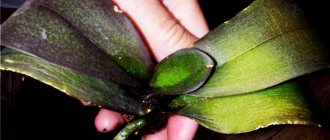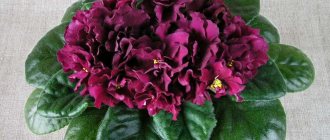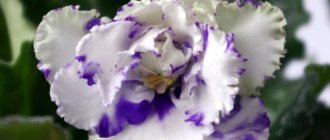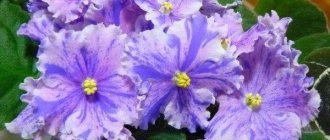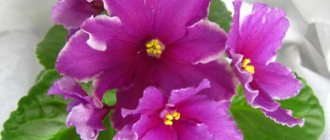In this article we will talk about Senk's The Sorceress, Senk's Longlegs, Senk's Neverland Dreams, Senk's Blue Cascade (R.Follett/D.Senk) violets , which are a less common type of trailer violets.
Trailers are the most unusual of the Gesneriaceae family . These plants are distinguished by a large number of growth points, and the stem of violets is very long. In some cases, the stem is so long that it hangs over 50 cm from the pot.
But the main advantage of trailer Saintpaulias is continuous flowering.
There are trailer Saintpaulias, which can be classified as standards (sheet reaches sizes of 3.8-5 cm), semi-miniatures (2.5-3.8 cm), miniatures (1.2-2.5), and microminiatures (0.6 -1.2 cm).
The size of the socket in trailers can be completely different and most often depends on the conditions of detention.
When growing such Saintpaulias, it is very important to pay attention to the formation of the rosette . A leaf with all the children, several children of different varieties, or one child is planted in a bowl. After the sprout forms four pairs of leaves, the top is carefully cut off.
Attention! Side shoots form in the axils. It is enough to leave three to five side shoots.
Subsequent care of the rosette involves timely removal of leaves so that the stems do not grow randomly and the cuttings are smooth and beautiful.
Characteristic
This violet variety was registered back in 2001. This variety is distinguished by large blue flowers. She was bred by a breeder named Konstantin Morev. It is noteworthy that the creator described his creation as “large double blue stars with a white border.”
The homeland of all violets can be considered East Africa , or rather one of its provinces, in which there was a governor named Saintpaulius. Today there are more than 2,000 varieties of these unusual flowers, so it is very difficult to say which specific geographic area the new varieties belong to.
Blue mist (violet) has a heavenly hue, hence the name
However, when creating a microclimate, it must be taken into account that plants prefer dry air.
Blue mist is a violet (photos show the variety of these flowers), which belongs to the category of a large variety. The outer part of the leaves can be of different shades - from light to rich green. The inner surface is usually lilac in color, but sometimes it is light green.
Blue Mist inflorescences have a beautiful heavenly hue. The flowers are large, spherical in shape. A wavy border runs along the edge of the petals; usually its color is a shade lighter than the main flower.
Violet flower stalks are very strong and rise above the leaves. On each peduncle, 3-4 large buds are formed, which bloom quite quickly. When Saintpaulia blooms in summer, the color of its flowers changes to soft blue, and the border becomes more saturated.
Then the border gradually disappears and appears again with the onset of cold weather. With the beginning of winter, the usual appearance of violets returns. During the propagation process, this variety often sports.
This means that new so-called subspecies are appearing, which can be divided into several groups:
- Variegated Violet Blue Mist. The flowers of this subspecies are darker in color, the border is very thin, white. The leaves are usually the same as those of the original violet of this variety, but sometimes they appear variegated with a light green color, which is how the subspecies got its name.
- Completely blue. This subspecies is distinguished by more elongated cuttings, which usually do not form a bush, but stretch upward. The flowers of this variety are completely blue, the same in shape as the original, but without the characteristic border.
- White with blue (Fantasy). This subspecies is almost no different from the original, especially in rosettes. The only difference is the colors, which can be white or slightly bluish. There is no border as such, but you can see unusual chaotic patterns on the petals.
Together with Blue Mist, you can grow other varieties of border-type violets, which will create more interesting compositions.
| Variety of fringed violet | Peculiarities |
| Compass roses | Violet flowers are more reminiscent of delicate roses of pale pink color. Closer to the edge of the petals, the color becomes more saturated. The edging is crimson, slightly green in places. |
| Natalis Estravagante | The variety is distinguished by unusual lace flowers of pale pink color. The border can also be pink (but more saturated), green or chocolate. The leaves of the violet are green, but closer to their edges you can see streaks of pink and white. |
| Beautiful Creole | Violet has an unusual appearance, is unpretentious, and prolific. The socket is compact. One plant produces many small, velvety, star-shaped, dark blue flowers. A contrasting white edge runs along the edge of each petal. The stems are burgundy in color. |
| Macho | A variety with fairly large semi-double flowers that form a lush head. Star-shaped corollas of Saintpaulia. Each petal has a visible bright white border. |
| Modern Talking | Violet is distinguished by semi-double white flowers with a pink-blue-violet border. Outwardly, they are very reminiscent of pansies. The leaves are light green, flat. |
Violets get along well with other plants, so there are no restrictions in this matter.
Violet Little Caboose (H.Pittman)
The Little Caboose variety was created by Hortense Pittman. This Saintpaulia is a semi-miniature. It blooms with semi-double or double flowers of a bright lavender hue.
The rosette is compact and round. Curly gel foliage with crown variegation.
Unlike other varieties, variegation does not completely disappear during the flowering period. It may become a little less, but it does not disappear completely.
Sometimes the young rosette is completely gold , but becomes green as it matures. But variegation returns during the recovery period after flowering or replanting, when new young leaves appear.
In the author's description, the variety is listed as semi-mini, but the rosette can rather be classified as a miniature. If you give enough light, the size does not exceed 7-9 cm .
The flowers resemble retro varieties. They are round and shaped like a perfect ball. Each flower has many petals, which are placed in the most bizarre manner. Immediately after the bud opens, it has a bright and rich color.
As they bloom, the petals change from dark purple to soft lilac. As a result, the bush begins to resemble a lilac branch. Also, the small petals exhibit a faint venous pattern, which adds to the attractiveness of the blooming rosette. There are no prints.
Little Caboose violet is not greedy for flowering . New flower stalks are constantly being formed, the old ones are still holding on, and new ones are already climbing out from the center of the rosette.
Attention! The variety is recommended for cultivation by experienced gardeners.
From the moment the cutting is planted to the first flowering, as a rule, more than a year passes. It reacts very strongly to temperature changes and can also die without proper care.
The growth and development of the rosette occurs very slowly. Sometimes you have to wait a very long time for flowering. Reacts sharply to excessive humidity.
The gel foliage is smooth and neat . It has a light green color and a white spot in the middle.
Variegation may appear with age if the violet receives enough light. As a rule, it does not disappear during the flowering period.
Sports varieties manifest themselves as a complete absence of variegation and terry.
Preparation of planting material and propagation
Blue mist (violet, photos of which prove the enormous diversity of this variety) is grown by propagation, that is, by pinching off a healthy leaf from another flower. However, seeds can also be found on sale. It is recommended to purchase such planting material only in specialized stores or trusted markets.
Otherwise, there is a risk of getting a violet of a different variety and shade. You also need to pay attention to the expiration date of the seeds. If they have been in the store for more than 2 years, they may not sprout.
For propagation you need to use strong, healthy and well-developed leaves. When using them, there is no need to carry out a disinfection procedure or other preparatory measures.
Preparing the soil and planting site
Particular attention should be paid to the correct soil mixture. In order for the flower to be strong and constantly delight with large inflorescences, the soil must be sufficiently loose and moisture-absorbing.
The substrate is prepared from 3 parts grain soil, 5 parts peat and 1 part sand. Or you can purchase a ready-made mixture in the store. It is recommended to choose only the substrate that is intended specifically for violets. It is also sold in any specialized store.
Violets feel best in plastic or ceramic pots. The first option is considered the most popular, since the plastic weighs little, does not oxidize and has a long service life. But it must be taken into account that air is not able to pass through such material.
There are more expensive, breathable pots on the market. Or you can prepare a plastic container yourself (it is important not to forget to make drainage holes). Typically, cut plastic bottles are used to plant leaves for propagation. After this you will need to select another pot.
Ceramic, clay and terracotta are breathable and are optimal for Saintpaulia. If the pot was previously used for another plant, then you need to wash it well in soapy water and dry it.
The best pots for violets are plastic
Since the surface of the material has a porous structure, salts can be retained in it, which are visible by characteristic stains. To get rid of them, you need to soak the containers in warm, soapy water for several hours.
You also need to decide on the size of the pot. If the container is very deep, then the violet will begin to form a very powerful rhizome. It requires more nutrition, which will lead to the formation of smaller flowers. Some violets stop blooming altogether in this situation.
A pot that is too small, on the contrary, will not be enough for a normal root system to develop in it. To choose the right container, you need to remember one simple rule - the pot should be slightly smaller than the top of the plant and then it will be the optimal size.
Landing algorithm
Violet Blue Mist, if you look at almost any photo or video instruction, is planted in the form of leaf cuttings that are prepared in advance. In order for roots to begin to grow on the cuttings, it is enough to select a large leaf of the 2nd lower tier of the mother plant.
Violet Blue Mist - propagation by cuttings
For it to take root, you need to pour a small amount of water into a dark container and put an activated carbon tablet in it. After this, it remains to lower the planting material into the water so that only its tip is in the liquid.
After a few weeks, full-fledged roots will form and it will be possible to plant them in the ground. If everything is done correctly, then within a month the plant will begin to actively develop and bloom. For some, I immediately plant the cuttings in the soil, where they take full root.
With this method, you need to ensure that the planting material does not fall. The easiest way to do this is to secure it with toothpicks. Additionally, the cuttings can be covered with polyethylene. This will speed up the plant development process. Usually, there are no problems with planting and propagating violets, but you need to remember some rules of care.
Reviews
Nina, Saratov. “This is one of my favorite outlets. The leaves have an ideal shape. The flowers are round, like fluffy balls. A bit reminiscent of retro varieties. Variegation often appears at a more mature age.”
Victoria, St. Petersburg. “Violet is very sensitive to change and care. If care is not correct, it simply will not bloom. But with proper care and favorable conditions it produces an abundant bouquet of flowers. The more light, the more saturated the color of the petals. But when sent by mail, the petioles often rot; this must be taken into account before ordering a plant from the catalog.”
Tatiana, Moscow. “My rosette had variegation only at an early age. After that she disappeared and never appeared again. But not so long ago the leaves began to rise up and get confused with each other. There were no changes in the conditions of detention. After these vagaries, I don’t even want to replant this variety.”
Care
Violet is undemanding, but requires standard care (especially with regard to watering rules and lighting conditions).
Spraying and watering
It is recommended to water violets through a tray. After water is poured into it, you need to wait 20 minutes and remove excess moisture. Fertilizers are applied using the same principle. There is another method of watering called wick.
It consists of placing the lace in a pot and bringing the other part out, lowering it into a container of water that will stand just below the level of the flower pot. In this case, replenishment will occur exactly when the plant needs it.
Another advantage of the method is that excess moisture is not formed, which often causes diseases in domestic plants. It is allowed to apply fertilizing using the wick method. But in this case, you need to reduce their concentration by 7 times.
Violet Blue Mist should be poured through the tray
The grower must also decide on the frequency of watering, which depends on several parameters:
- pot dimensions;
- ambient temperature and time of year;
- air humidity;
- depends on how long the plant has been blooming and on the condition of its inflorescences.
Violets need increased watering in the spring. At this time, it accumulates energy in order to form large and beautiful buds. In the cold season, it is better to water it less often to avoid waterlogging. You can tell if you are watering too often by looking at the leaves. Dark spots appear on them. This indicates that the root system has begun to rot.
There is a small pile on the leaves of Saintpaulia. Dust often accumulates on it. Therefore, you need to wash the leaves at least once a month. To do this, just place the pots of violets in the bath and pour a warm stream of water from the shower.
Water violet leaves in a trickle
No special drying is required. You need to wait until the water drops dry on their own and then you can move the plants back to the windowsill, exposing them to the sun. For irrigation, you can use exclusively raw tap water, which is pre-settled at room temperature.
It is better to water in a thin stream so that water does not fall on the leaves (especially if the weather is hot and the sun is shining brightly). The frequency of watering is 1 time every 3 days. You also need to periodically check the soil and moisten it as it dries.
Top dressing
Blue mist is a violet (photos of the variety are presented in the article), which may require additional nutrition. The first feeding is done 30 days after the flower has been transplanted. During this period, Saintpaulia requires additional microelements, which are necessary for full growth and flowering.
As a rule, Kemira Lux or Royal Mix fertilizers are used for this indoor plant. But other fertilizers intended for violets and gesneriaceae are also suitable. Some people use specialized Peters fertilizers.
Before using fertilizers, you must carefully study the instructions. As a rule, manufacturers indicate too high a dosage, which can be safely reduced by 2–3 times. This will allow you to fertilize a little more often, especially when the plant begins to bloom.
During this period, violet needs phosphorus and potassium, which are very important substances for proper budding. Fertilizer is applied only to moist soil. Otherwise, you can cause serious burns to the violet root system. Preference should be given to liquid or powdered fertilizers added to the water when watering.
If the plant does not have enough nutrients, then you can use liquid organic matter or sticks with feeding mixtures. Fertilizers can be applied for the first time already at the first flowering. You should not use too much fertilizer.
Especially if the soil mixture for growing violets was prepared according to all the rules or purchased in specialized stores. Such mixtures contain enough nutrients for 2-3 months. After this, you can move on to additional feeding.
In order for rosettes to develop better, you need to choose fertilizers based on nitrogenous substances. Potassium compounds are used to protect against diseases. You can also find ready-made complex formulations that contain all the necessary substances in the required proportions. They must be applied according to the instructions on the package.
Topping
It is necessary to pinch out leaves that look limp or have already died. As a rule, they are located at the very bottom and are practically in contact with the soil. You also need to promptly remove wilted flowers. Thanks to this, the plant will not waste its energy on almost dead parts. No additional pinching measures are required.
Transfer
Blue mist - violet (there is a photo of the plant processing process in the article) needs to be replanted when the root system of the plant develops so much that a larger pot is required.
When carrying out such an event, it is necessary to maintain the room temperature within 20-25 ° C, and the humidity should be 40-50%. It is best to repot in the spring, when the violet has enough sunlight to adapt to the new pot.
There are several ways to perform this procedure:
- Transshipment. Needed in a situation where the plant needs urgent replanting. To transfer, you need to remove the flower along with the soil clod from the pot. The new pot needs to be filled 1/3 with drainage. A flower is placed on it with a lump of earth. The indentations on the sides are filled with fresh soil mixture.
- Complete replacement. In this case, you need to thoroughly clean the roots from the old soil and remove all rotting parts. After this, the plant is placed in new soil.
After the procedure, it is necessary to water the plant and place it in a lighted place (preferably where the violet stood before transplantation).
Optimal conditions
If you provide the plant with proper care and prepare quality soil, it will bloom for up to 10 months a year. In addition, there will be significantly more colors. The advantage of this variety of violet is that even if it is very young, it already forms a beautiful blue cap in the first years of its life.
To do this, you need to adhere to a temperature regime of 20 to 25 ° C and avoid drafts, even short ones. It must be taken into account that this culture came from a hot country. But the violet leaves are quite fleshy and tender. Therefore, it is additionally necessary to provide shading or they may become sunburned.
It is also important to monitor the humidity level. It should be between 50 and 60%. If you decide to illuminate the plant, it is recommended to use only fluorescent lamps. It is important to maintain a distance of 25 cm between the light source and the plant.
Senk's The Sorceress
The name of the variety is translated as Sorceress . Authorship belongs to R. Follett,/D. Senk. Violet was registered in 2008.
Saintpaulia Senk`s The Sorceress refers to miniature trailers. The leaves are dark green, slightly pubescent, pebbly, and have a characteristic point. The flower is a double bell of a dark purple hue with a fringe.
A distinctive feature is the highly fleecy peduncles . They look a little like the legs of a bug.
This trailer can rather be classified as a bush variety. You shouldn’t expect half-meter-long shoots from it. Grows in a neat bush.
Photo of violet Senk's The Sorceress.
Sports can appear in the shape of a flower or its shade. Flowers may be pale and inconspicuous.
Example of sports.
Crooked petals and the presence of white color are a sign of a genetic disorder.
Features of keeping at home
For such Saintpaulias, it is very important to choose the right soil. It should be light and well-permeable to prevent the roots from rotting. Some gardeners use exclusively peat, vermiculite and perlite for the mixture without adding soil. Low, wide pots are used for planting.
Small plants tolerate transplantation well , but it is better not to touch a large violet again. If necessary, it is better to carefully remove the top layer of soil and add fresh soil.
Also, if the stems are hanging down, you should choose dishes with not very sharp edges.
When replanting completely, the leaves are removed everywhere except the crown. This will allow the plant to send out new side shoots. The stems must be spread on the surface of the soil.
Prefers lighting from 10 to 12 hours.
Fertilizers should only be given to mature plants . It is better to use complex fertilizer for flowers and leaves. Because the violet is constantly blooming and developing.
Watering is normal , once or twice a week. If the violet is very dry, you should not water the violet very sharply or too much. It is necessary to give liquid little by little.
Propagated by leaves or lateral shoots. For this purpose, an earthen mixture or sphagnum moss is used.
Reviews
Margarita, Moscow. “Not everyone understands the beauty of this sport, but I won’t give up on it. When standing on a wick, there are many more flowers, and they also have a much better shape and size.”
Maya, Korolev. “The flowers really resemble rudiments. Sometimes during the flowering period it seems that the bush has suffered a serious illness. But in place of each flower a small bump forms.”
Possible diseases and pests, ways to get rid of them
Violet Blue Mist can suffer from certain diseases and parasites:
- Spider mite. This insect attacks many indoor plants, including violets. The danger of spider mites is that they multiply and spread very quickly.
Its presence can be determined by the appearance of a sticky coating on the leaves. Some people wash plants with soap to combat it, but it is best to purchase a specialized product (for example, Fitoverm or Actellik) against this type of parasite.
Fitoverm helps get rid of spider mites
- Whitefly. As a rule, it appears on plants if the room humidity and temperature are too low. To control insects, you need to use a general insecticide.
- Mealybug. It is dangerous because it sucks the juices out of the plant, which is why it gradually withers, stops growing and may even die. To get rid of it, the most effective remedy is a soap solution.
- Powdery mildew. The development of the disease can be determined by the appearance of a white coating on the leaves of the plant. You can get rid of powdery mildew by treating it with a fungicide.
- Fusarium. When this disease develops, the violet can die very quickly. It is very difficult to identify fusarium in a timely manner, since the root system of plants is primarily affected.
As a rule, when the disease spreads to the foliage, it is too late to do anything. If the lesion has not yet reached the leaves, then you can cut off the entire healthy above-ground part of the flower and try to grow it again.
Violet Senk's Longlegs
Translated, the name of the flower sounds like Long Legs. Breeder – R. Follett/D. Senk.
Photo of Senk's Longlegs violet.
The variety belongs to the semi-miniature bush trailers. It does not produce half-meter shoots, but is valued for its unique long foliage (longifolia) with white and pink variegation.
Variegation appears exclusively at an early age and disappears completely over time. But there are specimens that retain their variegated leaves even in adulthood.
The leaves are long, reaching 5-6 cm. The shape should be elongated; if it is round, then it is a sport. The diameter of the rosette does not exceed 25 cm.
The bush forms independently; no additional pruning is required. This variety does not like a large number of growing points ; one head is enough.
The flower is a double or semi-double star of light lilac color with a fuchsia tint. It blooms profusely , but the periods between blooms are very long.
Grows into a palm tree . To prevent the flower pot from becoming bare, it is better to plant three plants in one container at once.
The stepson does not grow very abundantly. It is better to grow in one head , otherwise the violet will immediately thicken and give little flowering.
Sports varieties do not have the characteristic longophilic foliage . Sometimes children with round leaves grow from the correct petiole. Such lines are rejected, even if they produce beautiful flowering.
This specimen is very close to sports.
It grows very quickly and reproduces by both lateral shoots and leaves. Bushes well . You can plant one plant in a pot, or three in a wide bowl. It does not spread downwards, and over time it turns into a palm tree.
It blooms profusely, but the periods between blooms are very long . Primarily valued for its beautiful foliage.
Caring for the plant is the same as for other trailers.
Reviews
Masha, Vasilkov, Kiev region. “My bush remained variegated and did not turn green. The most likely cause is the cool and damp conditions.”
Larisa, Minsk. “I formed a beautiful rosette with four heads. None of my guests believe that this is actually a violet.”
Peculiarities
When growing Blue Mist violets, you need to take into account that this variety was bred artificially. This means that it has some characteristics that distinguish it from other plants. For example, Blue Mist can bloom in 10 months, while a regular violet rarely forms buds for such a long time.
It is believed that this variety is optimal for beginning flower growers, as it is unpretentious and its flower stalks are highly resistant. In addition, it is worth highlighting the very beautiful appearance of the flowers.
There are other advantages:
- Hypoallergenic. Violets do not produce pollen, which will make some household members feel unwell. However, in case of severe asthma, you should first talk to your doctor and find out if you can grow such flowers at home. Due to its hypoallergenic nature, Blue Mist is perfect for a child's room or bedroom.
- Additional purification of indoor air. Violets perfectly cleanse the surrounding atmosphere of harmful substances. This improves the microclimate of the entire house.
In addition, flowers of this type are able to absorb a variety of impurities contained in the air (for example, exhaust gases from the street). The violet releases oxygen. Therefore, the air is enriched. You can sleep much better in such rooms. But if the flowers are in the shade, then the reverse process begins, that is, carbon dioxide is released.
- Repelling ants. Insects often settle in apartments and it is very difficult to get rid of them, since just a few drops of water from the tap are enough for the ants to begin to actively reproduce. But they really don’t like violets and cannot be near them.
- Beneficial effect on the nervous system. Although violets do not have a distinct aroma, keeping them indoors makes it much easier to cope with stressful conditions. Some note that after growing Saintpaulia in a children's room, children become calmer and less capricious.
Blooming violet Blue mist becomes an excellent decoration for a room and a “living” background for beautiful photos. If you combine it with other plants, you can create a very unusual home flower bed. Growing these flowers does not require much effort. Thanks to rapid propagation by cuttings, you can quickly organize a real flower garden.
